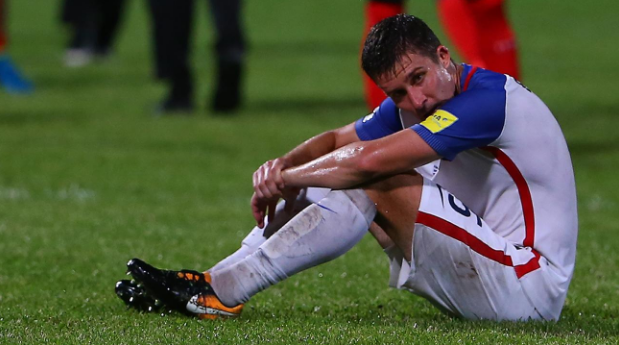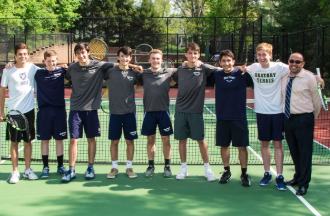Why USMNT Failed to Qualify for the World Cup Pt. 2
October 31, 2017
This week, I had the opportunity to speak with Varsity Soccer Coaches Joe Barresi and Connor Daugherty, and fervent soccer fan, Facilities Director, and English teacher Matthew Klarmann to get their takes on the U.S.’ terrible loss to Trinidad and Tobago that ended their World Cup Qualification hopes. Mr. Barresi believes there are two major issues with the U.S. National Team, one that could be solved in the short term and one that requires a long-term commitment. He thinks that coaches Jurgen Klinsmann and then Bruce Arena relied too heavily on established and successful, yet aging players for the qualification tournament. For example, “Players such as Tim Howard, Clint Dempsey, Alejandro Bedoya, Graham Zusi, Matt Besler, and Brad Guzan all were featured way too much during the qualifying campaign for their age.” As well, “A majority of our players during the entire qualifying process were over the age of 30, and to make matters worse the USMNT had essentially no players between the ages of 24-28 which are an athlete’s prime years.” Mr. Barresi believes the fix is simple, but it requires some hope and trust that the system will work. He proposes to “bring in younger, athletic guys who, although unproven, can give a spark to an aging team.” As well as leading to more success on the field, it could prod the aging members of the National Team to give all they have to not lose their spot to a newbie.
However, as much as this could help, Mr. Barresi believes there is an underlying problem that needs to be fixed over the long term for a more successful program. This starts with how the youth club is handled. Currently, “We (U.S.A.) have a system where a lot of the high level club teams require parents to pay large sums of money and various fees for things such as field time, travel, etc. The problem here is that this is where many of our youth USMNT athletes come from, but is not a good representation of our soccer players at the youth level. Some of the best athletes are coming from lower to middle class families, but in a system in which parents need to pay to have their sons play on these club teams, these players are not seen.”
Because of this, Mr. Barresi believes that a system more centered on scouting and recruiting to club teams where financial circumstances are not a problem is a necessity. He explains, “Most other countries around the world have a system in which players are signed at a young age as professionals and attend schools that are connected with the club teams. Obviously, this is a bit out of the norm for American ideals, but, at a bare minimum, scouting talent and having club teams support these players financially when it comes to the various fees needs to be improved.” Assistant Coach Daugherty highly agrees with this sentiment saying that it is necessary for more focus to be directed towards the youth program and that major changes need to be made so that anyone who would have the talent, drive, and belief is not ignored and has a chance to represent their country.
However, Mr. Daugherty has a slightly different approach as to why the U.S. lost so horribly to Trinidad and Tobago ending their chance of World Cup qualification. He believes that Coach Bruce Arena is primarily to blame for the extremely poor performance the U.S. put forth in the qualifying tournament. Coach Daugherty explains that Arena “has a very laid back style of playing and usually lets the game come to him and hopes that his defense will be able to handle the pressure.” However, this strategy did not seem to work for the U.S. as they lacked the clinical finishers at the top of the pitch and a strong goalie and defensive line to ensure victories at the back. Mr. Daugherty does shockingly find a positive from this horrific loss to Trinidad and Tobago, saying that “Sometimes a major power needs a shocking loss and the realization that they will not be playing on the world stage to spark a change in players, coaching, management, and whatever else is going wrong.”
He gives the example of the 2004 Olympics where the U.S. Men’s Basketball team suffered their biggest loss ever and only secured a bronze medal which sparked an aggressive overhaul for American Olympic Basketball. After this defeat, the U.S. Olympic Committee brought in Jerry Colangelo, who was a former Phoenix Suns Player and prominent basketball analysts to run U.S. Basketball. He then brought in Mike Krzyzewski, better known as Coach K, to manage the team and created a Dream Team that had not been seen since the era of Michael Jordan. Colangelo and K then brought in the best NBA players at the team that included LeBron James, Jason Kidd, Dwyane Wade, Chris Bosh, Chris Paul, Dwight Howard, Carmelo Anthony, and, perhaps most importantly, Kobe Bryant to captain the team. This all-star team dubbed the “Redeem Team” did exactly that, demolishing all of their opponents on the way to the final where they played and beat Spain whom they had lost to in 2004, accomplishing their ultimate goal of bringing the Gold Medal back to the USA. Mr. Daugherty is hoping that a similar thing happens with the U.S. National Soccer Team and that their loss to Trinidad is the spark that ignites the changes seen in 2008 with the Basketball program. He believes that if a transformation even slightly similar to the basketball renewal occurs for U.S. soccer than there is a very high chance that the embarrassment of not qualifying for the World Cup will never happen again.
OP Facilities Director Mr. Klarmann also provides an interesting opinion on the United States’ qualification efforts and the reasons for failure. He agrees with both Mr. Barresi and Mr. Daugherty that change needs to start with the cultivation of youth talent across America. He recommends that U.S. Soccer promote “the simpler, more creative and enjoyable part of the game, the type that is played without adult supervision/coaching; free, open, and public futsal courts should be available in urban areas, similar to basketball courts.” He explains that “Talent exists that was never turned onto the game or never had the opportunity to play the organized game,” saying that “We are choking the discovery of a lot of talent.”
Once U.S. soccer finds that best players that it possibly can, Mr. Klarmann recommends that “Youth players who wish to play at an international level be more encouraged to challenge themselves in the competitive world of European and top-level South American leagues.” He explains that “the ultra-competitive environment provides a place where players constantly battle for their jobs, force one another to improve, surround themselves with the greatest talent, learn from the most experienced coaches in the world, and thrust themselves into a fanatic soccer culture outside of the pitch.” This is contrary to the current philosophies of U.S. soccer as a majority of national team player come from the MLS even though this league “does not yet provide the ultra-competitive environment seen around the world.” Due to this MLS bias, many “young players in the top European and South American leagues were overlooked in the lineup or left off the squad entirely but should be part of the plans going forward. These players must be given the consistent chance to mesh as a cohesive unit for the United States National team. Some of these players are Terrence Boyd, John Brooks, Geoff Cameron, Timmy Chandler, Lynden Gooch, Ethan Horvath, Emerson Hyndman, Aron Johannsson, Fabian Johnson, Matt Miazga, Alfredo Morales, and Danny Williams.” If these Americans were given a chance, then there is a very good possibility that a different result could have been garnered in Trinidad, a birth to the 2018 World Cup.
Photo Credit: si.com

